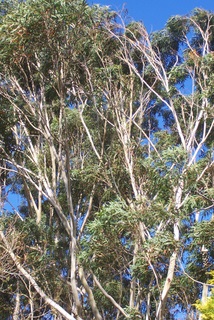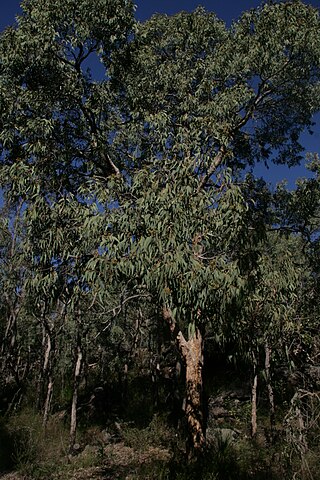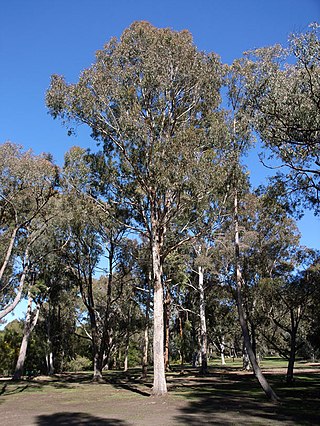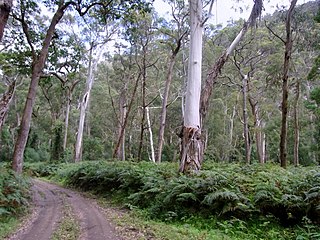
Mummel Gulf is a national park located in New South Wales, Australia, approximately 487 kilometres (303 mi) by road north of Sydney. It is situated approximately 50 kilometres (31 mi) southeast of Walcha on the unsealed Enfield Forest Road and 12 kilometres (7.5 mi) south of the Oxley Highway.

Ironbark is a common name of a number of species in three taxonomic groups within the genus Eucalyptus that have dark, deeply furrowed bark.

Eucalyptus obliqua, commonly known as messmate stringybark or messmate, but also known as brown top, brown top stringbark, stringybark or Tasmanian oak, is a species of tree that is endemic to south-eastern Australia. It has rough, stringy or fibrous bark on the trunk and larger branches, smooth greyish bark on the thinnest branches, lance-shaped to curved adult leaves, flower buds in groups of seven to fifteen or more, white flowers and cup-shaped or barrel-shaped fruit.

Eucalyptus botryoides, commonly known as the bangalay, bastard jarrah, woollybutt or southern mahogany, is a small to tall tree native to southeastern Australia. Reaching up to 40 metres high, it has rough bark on its trunk and branches. It is found on sandstone- or shale-based soils in open woodland, or on more sandy soils behind sand dunes. The white flowers appear in summer and autumn. It reproduces by resprouting from its woody lignotuber or epicormic buds after bushfire. E. botryoides hybridises with the Sydney blue gum in the Sydney region. The hard, durable wood has been used for panelling and flooring.
Messmate is a common name for a group of species of tree in the plant genus Eucalyptus, all of which have rough bark. The name is of uncertain origin.

Corymbia intermedia, commonly known as pink bloodwood, is a species of medium to tall tree that is endemic to north-eastern Australia. It has rough, tessellated bark on the trunk and branches, flower buds in groups of seven, white flowers and oval to barrel-shaped fruit.

Psaltoda moerens, commonly known as the redeye, is an Australian species of cicada. It is distributed through the south-east of Australia, from southern Queensland to South Australia, as well as Tasmania. Populations can vary greatly between years; one year they may be present in large numbers and the next they may be entirely absent. They feed primarily on eucalyptus but also on Angophora trees. As they feed on tree sap they expel small droplets of clear waste fluid. When numbers are high, this can form a constant stream.

Eucalyptus pilularis, commonly known as blackbutt, is a species of medium-sized to tall tree that is endemic to eastern Australia. It has rough, finely fibrous greyish bark on the lower half of the trunk, smooth white, grey or cream-coloured bark above, lance-shaped to curved adult leaves, flower buds in groups of between seven and fifteen, white flowers and hemispherical or shortened spherical fruit.

Eucalyptus oreades, commonly known as the Blue Mountains ash, white ash or smooth-barked mountain ash, is a species of medium-sized to tall tree that is native to eastern Australia. It has smooth, powdery whitish bark with rough bark near the base, lance-shaped to curved adult leaves, flower buds in groups of seven, white flowers and cup-shaped to cylindrical fruit.

Eucalyptus deanei, commonly known as mountain blue gum, round-leaved gum, or Deane's gum, is a species of large tree endemic to New South Wales. It has smooth bark, lance-shaped leaves that are paler on the lower surface, flower buds in groups of seven to eleven, white flowers and cup-shaped to bell-shaped fruit.

Eucalyptus paniculata, commonly known as grey ironbark, is a species of tree that is endemic to New South Wales. It has dark-coloured, deeply furrowed ironbark on the trunk and branches, lance-shaped to curved adult leaves, flower buds in groups of seven on a branched peduncle, white flowers and conical, hemispherical or cup-shaped fruit.

Eucalyptus acmenoides, commonly known as white mahogany or barayly, is a tree that is endemic to eastern Australia. It is a large tree with grey to reddish brown, stringy bark, lance-shaped leaves, oval to spindle-shaped buds and more or less hemispherical fruits. The two sides of adult leaves are very different shades of green.

Corymbia eximia, commonly known as yellow bloodwood, is a bloodwood native to New South Wales. It occurs around the Sydney Basin often in high rainfall areas on shallow sandstone soils on plateaux or escarpments, in fire prone areas. Growing as a gnarled tree to 20 m (66 ft), it is recognisable by its distinctive yellow-brown tessellated bark. The greyish green leaves are thick and veiny, and lanceolate spear- or sickle-shaped. The cream flowerheads grow in panicles in groups of seven and appear in spring. Known for many years as Eucalyptus eximia, the yellow bloodwood was transferred into the new genus Corymbia in 1995 when it was erected by Ken Hill and Lawrie Johnson. It is still seen under the earlier name in some works.

Eucalyptus albens, known as the white box, is a common tree of the western slopes and plains of New South Wales and adjacent areas in Queensland and Victoria. It has rough, fibrous bark on the base of its trunk and smooth, white bark above. The leaves are lance-shaped and groups of seven spindle-shaped flower buds are arranged in leaf axils or on the ends of the branches. White flowers are mostly present between August and February and the fruit are barrel-shaped to urn-shaped.

Eucalyptus sclerophylla, known as the scribbly gum, is a tree native to eastern Australia. Very similar to the related Scribbly Gum , a better known tree. The best way of distinguishing the species is the smaller hemispherical to pear shaped gumnuts of Eucalyptus sclerophylla, being 0.6 cm by 0.6 cm in size. Flower buds are also smaller. sclerophylla literally means hard leaf. Both species have hard leaves, but Eucalyptus sclerophylla's leaves are particularly hard edged.

Eucalyptus agglomerata, commonly known as blue-leaved stringybark, is a tree endemic to eastern Australia. It has persistent, stringy bark, green or greyish leaves with a bluish sheen, flower buds in groups of eleven to fifteen, white to cream-coloured flowers and crowded, flattened hemispherical fruit.

Eucalyptus bosistoana, commonly known as the coast grey box or Bosisto's box, is a tree that is endemic to south-eastern Australia. It has rough, flaky bark at the base of its trunk, smooth cream yellow or grey bark above and sometimes throughout, the smooth bark shed in ribbons. The adult leaves are lance-shaped to curved and the flower buds are arranged in groups of seven. The flowers are white and the fruit is a cup-shaped, barrel-shaped or hemispherical capsule.

Eucalyptus mediocris, commonly known as inland white mahogany, is a eucalypt that is endemic to the Australian state of Queensland.

The Southeast Australia temperate forests is a temperate broadleaf and mixed forests ecoregion of south-eastern Australia. It includes the temperate lowland forests of southeastern Australia, at the southern end of the Great Dividing Range. Vegetation ranges from wet forests along the coast to dry forests and woodlands inland.


















